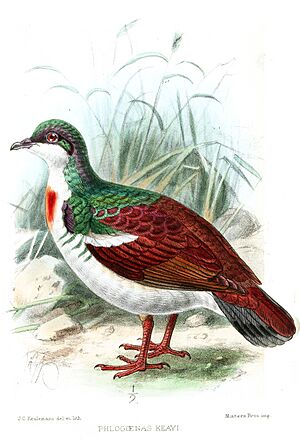Negros bleeding-heart pigeon facts for kids
Quick facts for kids Negros bleeding-heart |
|
|---|---|
 |
|
| Gallicolumba keayi as Phlegoenas keayi |
|
| Conservation status | |
| Scientific classification | |
| Genus: |
Gallicolumba
|
| Species: |
keayi
|
The Negros bleeding-heart pigeon (Gallicolumba keayi) is a very special bird. It lives only in the Philippines, on the islands of Negros and Panay. This pigeon is in great danger. It is called critically endangered. This means there are very few left in the wild.
Experts believe only about 50 to 249 adult birds are still alive. Their homes are disappearing because of forest loss. This makes their population very small and spread out. The Zoological Society of London lists this bird as an EDGE species. This means it is very unique and needs urgent help to survive.
This pigeon is one of the "Big 5" animals found in the Western Visayas region. The other four are the Walden's hornbill, Visayan spotted deer, Visayan hornbill, and the Visayan warty pig.
Contents
What Does the Negros Bleeding-Heart Pigeon Look Like?
This pigeon is a medium-sized bird that lives on the forest floor. It is about 25 centimeters (10 inches) long. Its head and sides of its chest are a shiny greenish-blue color. Its upper back has a scaled pattern. The flight feathers on its wings are brownish.
The pigeon has white underparts. This white color narrows from its throat down to its belly. You can also see clear white crescent shapes on its wings and chest. The most special part is the bright red "bleeding heart" patch in the middle of its chest. This patch makes it easy to identify.
If you see a bird fly up from the ground, it's likely this pigeon. The only other similar bird is the Asian emerald dove. The Negros bleeding-heart pigeon makes a short, fast series of low sounds.
Daily Life and Reproduction
The Negros bleeding-heart pigeon finds its food on the ground. However, it sleeps and builds its nests on bushes or vines. These birds are often seen in pairs or small groups.
Scientists have found birds ready to lay eggs in April and May. They also found a young bird that had just learned to fly in May. These pigeons build their nests from March to June. Their chicks leave the nest after only 12 days. This quick growth might help them survive. Their nests are often open and low, making them easy targets for predators.
These pigeons mostly eat plants. But there is some evidence that they might also eat small insects found on the ground.
Where Does the Negros Bleeding-Heart Pigeon Live?
The Negros bleeding-heart pigeon mainly lives in old, untouched forests. These are called primary forests. They live in areas up to 1,200 meters (about 3,900 feet) above sea level. They do not like when their home is disturbed. They don't do well in forests that have grown back after being cut down, called secondary forests.
Why Is This Pigeon in Danger?
This pigeon is critically endangered. This means it faces a very high risk of dying out in the wild. As mentioned, only about 50 to 249 adult birds are left.
The biggest threats to these birds are:
- Habitat Loss: Their forest homes are disappearing fast. By 2007, Negros island had only 3% of its original forest left. Panay island had only 6%. Most of these remaining forests are in high mountains where the pigeons don't live.
- Deforestation: Forests are still being cut down. This happens because of legal and illegal logging, farming, mining, and building roads.
- Hunting and Trapping: People hunt these birds for food. They also trap them to sell as pets.
Helping the Negros Bleeding-Heart Pigeon
Good news! In 2007, the Negros bleeding-heart pigeon was bred in captivity for the first time. This happened at the Center for Tropical Conservation Studies. By 2013, there were 18 birds in captivity. Most of these birds were rescued from illegal bird trade.
The Talarak Foundation and the Philippines Biodiversity Conservation Foundation are working together. They are helping to breed these birds. There are plans to release some of these birds back into the wild in the future.
To help save these pigeons, here are some important actions:
- Find Them: Explore areas where they have been seen. Look for other places with good habitats.
- Protect Homes: Keep existing forests safe. The Northern Negros Forest Reserve is one important area.
- Plant Trees: Encourage planting native trees to grow back forests.
- Educate People: Create campaigns to teach people about conservation. This can help stop hunting and the pet trade.


